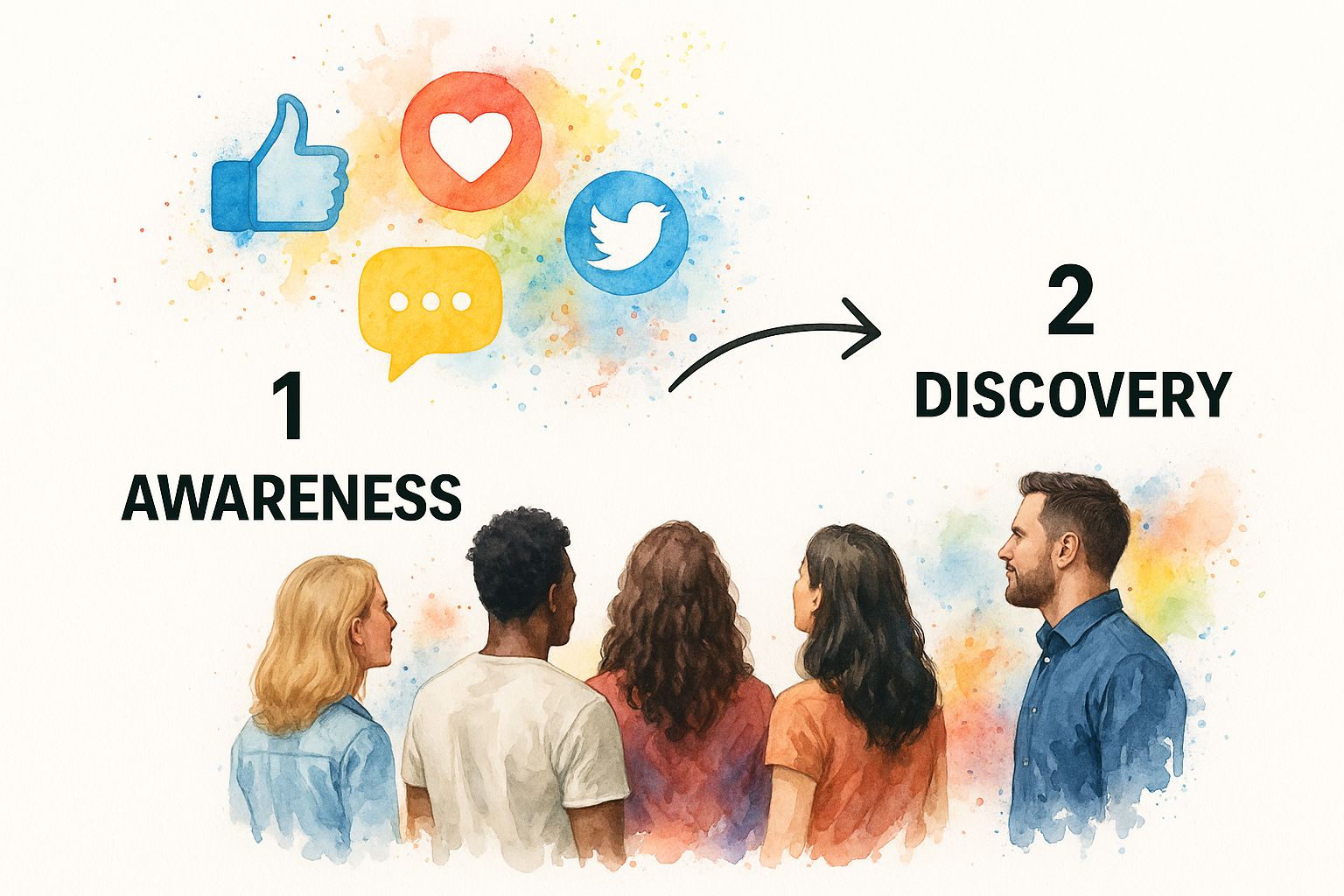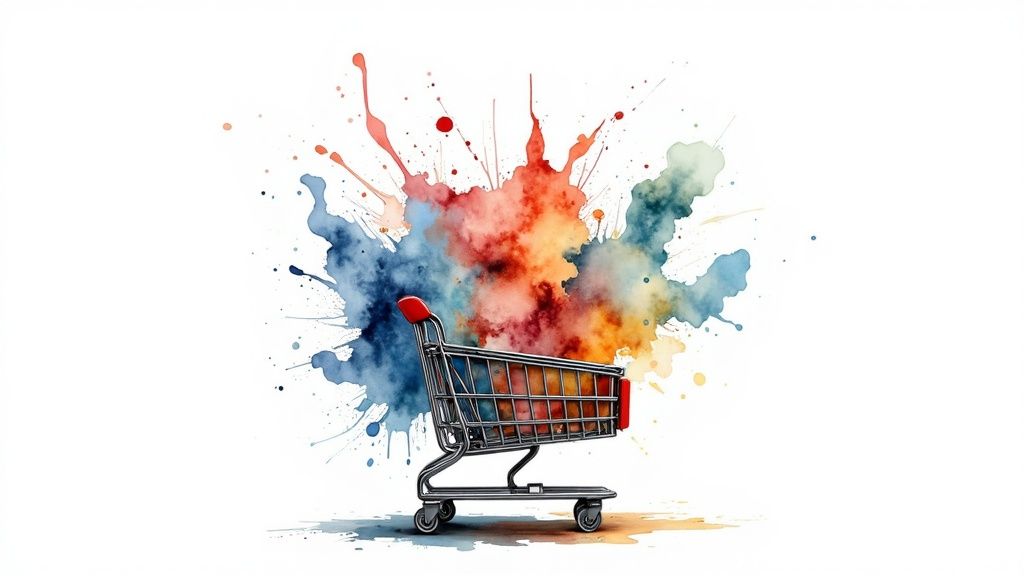Master Your Social Media Funnel: Convert Followers Today

Understanding Your Social Media Funnel Foundation
Think of your social media funnel not as a rigid sales process, but as your brand’s digital handshake and conversation starter. It's a method for turning complete strangers on social platforms into loyal customers and, eventually, vocal supporters of your brand. This approach moves beyond simply shouting ads at people. Instead, it focuses on genuine interaction and building a community that trusts you.
This shift isn't just a trend; it's a reflection of how people live today. Over 5.2 billion people, or roughly 64% of the world's population, use social media. With the average person spending 2 hours and 21 minutes scrolling each day, the opportunity to connect is massive. However, it's the quality of that connection that truly matters. To get a better sense of these numbers, you can explore more data on global social media usage and see the scale for yourself.
From Traditional to Social: A New Blueprint
The classic sales funnel is a straightforward, one-way street. You pour a large number of potential customers in at the wide top (Awareness), and a much smaller, filtered group comes out the bottom as buyers (Action). It’s a linear journey from A to B.
While this model provides a useful starting point, it doesn't quite capture the messy, dynamic, and conversation-driven path of today's social media user. The social media funnel is less of a cone and more of a web, with multiple touchpoints and ongoing dialogue.
The Core Differences
The biggest change is how we engage with customers. Traditional funnels were built on one-way communication—think billboards or TV commercials. A social media funnel, on the other hand, is built on a two-way conversation. It uses shares, comments, and direct messages to create a relationship long before a sale is ever made.
To see these differences side-by-side, let's compare the two approaches.
Traditional vs Social Media Funnel Comparison
Key differences between traditional marketing funnels and social media funnels in approach, engagement, and conversion tactics
| Aspect | Traditional Funnel | Social Media Funnel | Key Benefit |
|---|---|---|---|
| Communication | One-way broadcast (e.g., TV ads, print) | Two-way, interactive conversation | Builds authentic community and trust |
| Customer Journey | Linear and predictable (Awareness > Action) | Non-linear and dynamic, with multiple entry points | Caters to modern customer behavior |
| Primary Goal | Drive a direct transaction or sale | Foster relationships and build brand advocacy | Creates long-term customer loyalty |
| Engagement Style | Passive consumption of marketing messages | Active participation, content sharing, and dialogue | Generates organic reach and social proof |
The table highlights that while the traditional funnel is focused on the immediate sale, the social media funnel plays the long game. It prioritizes building a community that not only buys from you but also champions your brand to others.
By understanding this fundamental shift, you can design a funnel that doesn't just push for conversions. Instead, you'll create an ecosystem where relationships come first, knowing that sales will naturally follow from that foundation of trust.
Mapping Each Stage of Your Customer Journey
To get a real grip on the social media funnel, let's follow a potential customer's path. This isn't a single leap from stranger to buyer. Instead, it's a journey of small steps and connected moments that gradually build a relationship with your brand.
This infographic shows how different people find and interact with brands on social media, starting them on their way through the funnel.

The image highlights that today's customer journey can start on many different platforms. This makes a unified, cross-channel plan vital for grabbing that first bit of attention.
From Discovery to Decision
The funnel kicks off with the Awareness stage. Think of this as your brand's digital handshake. Someone might see you for the first time through a friend's share, a targeted ad, or a Reel that's getting a lot of views. The goal isn't to sell; it's simply to get on their radar and spark some curiosity.
Next comes the Interest stage. This is where that initial spark turns into active engagement. They might follow your account, like a few posts, or click a link to one of your articles. These actions are signals that they're interested and want to learn more about what you have to offer.
As their interest grows, they move into the Consideration stage. Now, they are actively looking at your solution. They might drop a question in your comments, slide into your DMs, or see how you stack up against competitors. Building a solid relationship here is key. Success often means giving valuable information and social proof that answers their questions and builds their confidence. This is a prime moment for effective social media lead generation, as these engaged prospects are showing they're ready to take the next step.
Turning Followers into Fans
The Conversion stage is where all your effort comes together. After you've built trust and shown your value, the user is finally ready to act. This could be making a purchase, starting a free trial, or booking a call. Your content at this point should make this decision feel like the most natural thing to do.
But the journey doesn't stop at the sale. The last and most valuable stage is Advocacy. This is where happy customers become your biggest cheerleaders. They leave glowing reviews, tell their friends about you, and post their own content featuring your products. These advocates are your most believable marketing tool, kicking off the funnel all over again for a new audience.
This entire flow is shaped by how people use social media today. The average person interacts with about 6.83 different social networks each month, creating more opportunities than ever for brands to connect. You can read more about these social media statistics to better understand this multi-platform world.
Platform-Specific Strategies That Actually Work
A successful social media funnel isn't a one-size-fits-all blueprint. Each platform has its own unique culture, user behaviors, and content expectations. What gets an audience excited on TikTok might seem completely out of place on LinkedIn. Treating each channel as its own distinct environment is essential for guiding users from discovery to conversion. A generic approach will almost certainly fall flat, but adapting your strategy to each platform’s personality will deliver much better results.
Think of it this way: you wouldn't use the same tone and topics at a professional networking event as you would at a casual backyard barbecue. In the same way, your funnel tactics must align with the social context of the platform you're on.
Mastering the Major Platforms
Let’s explore how to build your funnel on some of today's most popular social networks. Different platforms are better suited for certain stages of the customer journey, so a smart strategy often involves using them in combination to achieve your goals.
- Facebook & Instagram: These visual-first platforms are powerhouses for the entire funnel. For top-of-funnel Awareness, you can use eye-catching Reels and Stories. To move people into the Consideration stage, run targeted ad campaigns and use Instagram Shopping tags to let people explore your products. To drive Conversions, use direct calls-to-action in your ads and take advantage of the simple checkout features.
- LinkedIn: As a professional network, LinkedIn is perfect for B2B funnels. Your goal at the top of the funnel should be to build authority with thought-leadership articles and insightful commentary. You can then nurture leads in the middle stage with detailed case studies or webinar invitations. The conversion stage here is more about relationship building, often leading to a sales call or a demo request rather than an immediate online purchase.
- TikTok & YouTube: These video-focused platforms are incredible for generating massive Awareness and deep Interest. On TikTok, you can use trending audio and quick, educational clips to capture attention. On YouTube, long-form tutorials and in-depth product reviews can build significant trust, moving viewers from the interest stage right into consideration.
A Closer Look at Facebook’s Funnel Power
Facebook's massive user base and detailed targeting options make it a vital component of nearly any social media funnel. The platform supports a complete customer journey, from the first moment someone discovers your brand all the way to post-purchase engagement. For instance, its advertising tools let you create custom audiences based on actions people have taken, like watching your videos or visiting your website.
Here’s an example from Facebook’s Ads Help Center that shows how to set up a campaign focused on a conversions objective.

This interface shows just how specific you can get, optimizing for actions like "Add to Cart" or "Purchase." This level of control is fundamental for the bottom of your funnel. With over 2.9 billion monthly active users, the platform gives you unparalleled reach to guide prospects toward a decision. You can discover more social media advertising trends to better grasp the potential available.
Content That Moves People Through Your Funnel
Content is the fuel for your social media funnel, but not all content works the same way. Simply chasing likes and shares won't reliably guide people toward a purchase. Instead, every piece of content should have a specific job tied to a funnel stage, acting as a purposeful step in the customer's journey. This approach turns passive scrollers into active prospects.
Think of your content as a series of conversations. Each one is designed to move the relationship forward, building understanding and trust over time. This requires a well-planned content calendar that maps different types of posts to specific funnel objectives. A structured approach ensures you’re not just posting randomly but are strategically nurturing your audience.

An organized calendar like this is the backbone of an effective social media funnel. It helps you see the entire customer journey at a glance and ensures you have the right message ready for every step.
Content by Funnel Stage
To make this practical, let's explore the types of content that perform best at each stage of the funnel.
-
Top-of-Funnel (Awareness): The goal here is to grab attention and introduce a problem or idea your audience cares about. This is your digital handshake. Create content that makes people stop scrolling, such as short educational videos, insightful infographics, or relatable posts that highlight a common challenge. Video is especially powerful here; 78% of people prefer learning about new products through short clips. You can explore more social media statistics to see how video continues to dominate.
-
Middle-of-Funnel (Consideration): Now that you have their attention, it's time to build trust. Share content that showcases your expertise and demonstrates your value. This includes behind-the-scenes glimpses, customer success stories, and case studies that answer common questions. This stage is all about deepening the relationship and showing people why you are the right solution. Effective social media community management is key, as you'll be engaging in more detailed conversations.
-
Bottom-of-Funnel (Conversion): The final step is to gently guide them toward making a decision. This content should remove any last-minute doubts and make converting feel like the natural next step. Use compelling testimonials, detailed product demos, and clear, non-pushy calls-to-action (CTAs). This is where the trust you've built pays off, turning an interested follower into a loyal customer.
To help you visualize this strategy, here is a table breaking down the content types, objectives, and metrics for each funnel stage.
Content Types by Funnel Stage
Recommended content formats and objectives for each stage of the social media funnel
| Funnel Stage | Content Types | Primary Objective | Success Metrics |
|---|---|---|---|
| Top-of-Funnel (Awareness) | • Short educational videos • Infographics & checklists • Blog posts & articles • Relatable memes & GIFs |
Capture attention and educate a broad audience. | Reach, impressions, video views, brand awareness lift. |
| Middle-of-Funnel (Consideration) | • Customer success stories • Case studies • Behind-the-scenes content • Webinars & Q&A sessions |
Build trust and showcase expertise and value. | Engagement rate, link clicks, comments, lead magnet downloads. |
| Bottom-of-Funnel (Conversion) | • Product demos & tutorials • Customer testimonials & reviews • Limited-time offers • Clear calls-to-action (CTAs) |
Overcome final objections and encourage a purchase. | Conversion rate, sign-ups, sales, cost per acquisition (CPA). |
This table shows how each piece of content has a distinct role. Awareness content casts a wide net, consideration content builds a strong connection, and conversion content provides the final push needed to make a sale.
Optimizing for Better Conversions
Building your social media funnel is a great first step, but the real magic happens during optimization. This is where you dig into the data, find out where you’re losing potential customers, and make smart tweaks that add up to big results. True optimization goes beyond tracking likes and shares; it’s about connecting your social media efforts to actual business growth.
Identifying and Fixing Bottlenecks
The first step in any optimization process is to figure out where people are dropping off. Are they seeing your posts but not clicking the links? Are they browsing your product pages but never making it to checkout? To answer these questions, you need to have solid tracking in place. Tools like UTM parameters and website analytics allow you to follow the customer’s path and see exactly where the friction points are.
Once you’ve found a bottleneck, you can start testing solutions. A/B testing is a perfect method for this. For instance, you could test:
- Ad Creative: Does a video ad catch the eye of your mid-funnel audience more effectively than a static image?
- Audience Targeting: Is a lookalike audience built from past buyers more effective than one based on general website visitors?
- Organic Content: Does publishing bottom-of-funnel content in the morning drive more sales compared to the evening?
Investing in these tests is essential. Brands are projected to spend $276.7 billion on social media advertising this year, a figure that highlights the massive effort companies put into perfecting every stage of their funnels. You can discover more insights about social media ad spending on Sprout Social to see the scale of this investment.
Advanced Retargeting and Social Listening
One of the most powerful optimization strategies is advanced retargeting. This is much more than just showing a generic ad to everyone who visited your site. Instead, it involves creating specific campaigns for users based on the actions they took—or didn't take. For example, you could target users who watched 75% of a product demo video with a testimonial ad that overcomes common buying objections. This kind of targeted follow-up is directly tied to a healthier funnel. If you want to dive deeper, you can learn more about how to increase social media engagement in our detailed guide.
Another valuable technique is social listening. Using tools to monitor conversations about your industry or brand helps you proactively spot conversion opportunities. By listening in, you can identify common questions, complaints, or hesitations people have before they buy. Addressing these pain points directly in your content helps clear the path for customers, making their journey through your social media funnel much smoother.
Avoiding the Funnel Mistakes That Kill Conversions
Building a powerful social media funnel is one thing, but preventing it from springing a leak is another. Even the most carefully planned strategies can falter when common mistakes appear, disrupting the customer journey just as it’s getting started. These pitfalls can waste your budget and stop your growth, making them essential to spot and fix.
Mismatched Platforms and Messages
A frequent error is treating every social media platform as if it’s identical. A formal, detailed post created for LinkedIn will likely fall flat in the fast-paced, trend-heavy world of TikTok. Each platform has its own distinct culture, audience, and content expectations. Ignoring these differences is like trying to speak the same language to everyone in a foreign country—the message simply won’t land.
Instead, adjust your content to fit the specific environment:
- LinkedIn: Share professional insights, B2B success stories, and thought leadership articles.
- Instagram: Focus on high-quality visuals, behind-the-scenes Stories, and entertaining Reels.
- TikTok: Create short, fun, and educational videos that connect with current trends.
- Facebook: Combine community-building content with targeted ads and in-depth event promotions.
The Vanity Metrics Trap
Another critical mistake is getting distracted by top-of-funnel metrics that look impressive but mean very little. High reach and impression counts feel good, but they don’t translate into revenue. Chasing likes while ignoring lead generation or sales is a fast track to a broken funnel. This issue often happens when businesses fail to track the entire customer journey from start to finish.
The image below from HubSpot points out several common marketing errors, including the failure to track and analyze the right data, which is fundamental to optimizing your funnel.
The takeaway here is that effective marketing—and by extension, a successful social media funnel—depends on understanding performance at every stage, not just what's visible on the surface.
Inconsistent Messaging and Pacing
Finally, many brands create a jarring experience through inconsistent messaging or by rushing their audience. A potential customer who enjoys a friendly, educational post at the top of the funnel might be put off by an aggressive, sales-focused ad the very next day.
Nurturing a relationship takes time. Pushing for a sale before you’ve earned enough trust is a reliable way to lose a potential customer. Make sure your messaging evolves naturally, giving prospects the room they need to move from one stage to the next at a comfortable pace.
Measuring Success and Scaling Your Results
What gets measured gets managed, and your social media funnel is no exception. To build lasting growth, you need to look past surface-level numbers like follower counts and focus on metrics that actually signal business success. This means setting up tracking that connects your social media efforts directly to your bottom line.
Think of it like a doctor checking a patient's vital signs. A high number of impressions is like a fast heart rate—interesting, but not the whole story. The real indicators of long-term health are things like your conversion rate (blood pressure) and customer lifetime value (cholesterol levels). A solid measurement strategy is your diagnostic tool, showing you how your funnel is performing at every single stage.
Connecting Actions to Outcomes
A crucial part of this is getting a clear view of your data. Using tools like website analytics helps you trace the entire customer journey, from the moment they click on a social media post to the final purchase.
Here’s a snapshot of a typical analytics dashboard, which helps you see how users from different sources behave on your site.
This kind of view allows you to identify which platforms are driving not just clicks, but valuable actions. It helps you make smarter decisions about where to invest your time and budget. You can quickly spot if your efforts on one platform are leading to more meaningful engagement or sales than on another.
Scaling What Works
Once you have a clear picture of your funnel's performance, you can start to systematically scale what’s successful. This data-first approach lets you make informed choices about how to allocate your resources for maximum impact.
Here are a few practical ways to scale your results:
- Test New Platforms: If your data shows that short-form videos drive high engagement on one platform, try a similar strategy on another video-focused network.
- Refine Audience Targeting: Use insights from your top-performing campaigns to build lookalike audiences. This helps you reach new people who share characteristics with your best customers.
- Double Down on Winning Content: Pinpoint the content formats that consistently guide users from one funnel stage to the next, and then create more of what works.
By adopting a cycle of continuous measurement and data-supported adjustments, you can keep your social media funnel running efficiently, adapting to market shifts while driving predictable growth.
Ready to automate your engagement and keep your funnel full around the clock? GrowChief acts as your AI-powered engagement agent, ensuring your profile is always interacting with relevant audiences and driving conversations. Start your free 7-day trial of GrowChief today and turn your social media presence into a growth engine.






